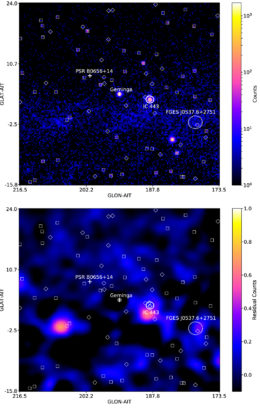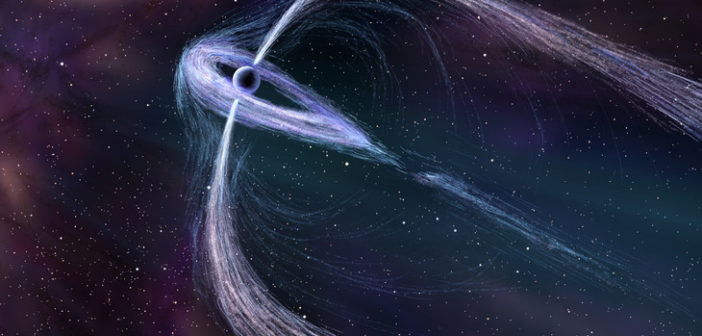The Earth is constantly being bombarded by cosmic rays — high energy protons and atomic nuclei that speed through space at nearly the speed of light. Where do these energetic particles come from? A new study examines whether pulsars are the source of one particular cosmic-ray conundrum.
An Excess of Positrons

Artist’s impression of the shower of particles caused when a cosmic ray hits Earth’s upper atmosphere. [J. Yang/NSF]
Positrons — the antimatter counterpart to electrons — are thought to be primarily produced by high-energy protons scattering off of particles within our galaxy. These interactions should produce decreasing numbers of positrons at higher energies — yet the data from PAMELA and other experiments show that positron numbers instead go up with increasing energy.
Something must be producing these extra high-energy positrons — but what?
Clues from Gamma-rays
One of the leading theories is that the excess positrons are produced by nearby pulsars — rapidly rotating, magnetized neutron stars. We know that pulsars gradually spin slower and slower over time, losing power as they spew a stream of high-energy electrons and positrons into the surrounding interstellar medium. If the pulsar is close enough to us, positrons produced in and around pulsars might make it to Earth before losing energy to interactions as they travel.

Observations from the High-Altitude Water Cherenkov (HAWC) Gamma-Ray Observatory show TeV nebulae around pulsars Geminga and PSR B0656+14. But do these sources also have extended GeV nebulae that would provide more direct constraints on positron density? [John Pretz]
To test whether pulsars are responsible for the positrons we see, Xi and collaborators argue that we should look for GeV emission around candidate sources. As the pulsar-produced positrons diffuse outward, they should scatter off of infrared and optical background photons in the surrounding region. This would create a nebula of high-energy emission around the pulsars that glows at 10–500 GeV — detectable by observatories like the Fermi Gamma-ray Space Telescope.
Two Pulsars Get an Alibi

Fermi LAT gamma-ray count map (top) and residuals after the background is subtracted (bottom) for the region containing Geminga and PSR B0656+14. [Adapted from Xi et al. 2019]
The result? They find no evidence of extended GeV emission around these sources. The authors’ upper limits on emission from Geminga and PSR B0656+14 give these objects an alibi, suggesting that pulsars can likely account for only a small fraction of the positron excess we observe.
So where does this leave us? If pulsars are cleared, we will need to look to other candidate sources of high-energy positrons: either other nearby cosmic accelerators like supernova remnants, or more exotic explanations, like the annihilation or decay of high-energy dark matter.
Citation
“GeV Observations of the Extended Pulsar Wind Nebulae Constrain the Pulsar Interpretations of the Cosmic-Ray Positron Excess,” Shao-Qiang Xi et al 2019 ApJ 878 104. doi:10.3847/1538-4357/ab20c9

3 Comments
Pingback: Should We Blame Pulsars for Too Much Antimatter? – Hamilton County Weather
Pingback: Should We Blame Pulsars for Too Much Antimatter? – Sky & Telescope | SPACE FORCE
Pingback: Should We Blame Pulsars for Too Much Antimatter? – Dinezh.com